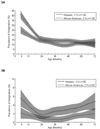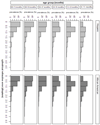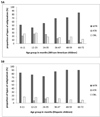Prevalence of astigmatism in 6- to 72-month-old African American and Hispanic children: the Multi-ethnic Pediatric Eye Disease Study
- PMID: 20888047
- PMCID: PMC3017730
- DOI: 10.1016/j.ophtha.2010.06.038
Prevalence of astigmatism in 6- to 72-month-old African American and Hispanic children: the Multi-ethnic Pediatric Eye Disease Study
Abstract
Purpose: To determine the age-, gender-, and ethnicity-specific prevalence of astigmatism in African American and Hispanic children aged 6 to 72 months.
Design: Population-based, cross-sectional study.
Participants: The Multi-Ethnic Pediatric Eye Disease Study is a population-based evaluation of the prevalence of vision disorders in children ages 6 to 72 months in Los Angeles County, California. Seventy-seven percent of eligible children completed a comprehensive eye examination. This report provides the results from 2994 African American and 3030 Hispanic children.
Methods: Eligible children in 44 census tracts were identified during an in-home interview and scheduled for a comprehensive eye examination and in-clinic interview. Cycloplegic autorefraction was used to determine refractive error.
Main outcome measures: The proportion of children with astigmatism defined as cylindrical refractive error ≥ 1.50 diopters (D) in the worse eye. The astigmatism type was defined as with-the-rule (WTR) (+ cylinder axis 90 ± 15 degrees) and against-the-rule (ATR) (+ cylinder axis 180 ± 15 degrees); all other orientations were considered oblique (OBL). The prevalence of astigmatism and its types were also determined for worse eye cylindrical refractive error ≥ 3.00 D.
Results: Prevalence of astigmatism ≥ 1.50 D was higher in Hispanic children compared with African American children (16.8% vs. 12.7%, respectively; P<0.0001). Hispanic children also showed a higher prevalence of astigmatism ≥ 3.00 D than African American children (2.9% vs. 1.0% respectively; P<0.0001). The prevalence of astigmatism ≥ 1.50 D showed a significant decreasing trend with age (P<0.0001). The prevalence of WTR, ATR, and OBL astigmatism ≥ 1.50 D was 13.9%, 0.6%, and 2.2%, respectively, in Hispanic children, and 7.8%, 2.2%, and 2.7%, respectively, in African American children.
Conclusions: We observed ethnicity-related differences in astigmatism prevalence in preschool children. The age-related decrease in astigmatism prevalence in preschool children likely reflects emmetropization.
Copyright © 2011 American Academy of Ophthalmology. Published by Elsevier Inc. All rights reserved.
Conflict of interest statement
Figures







References
-
- Chan OY, Edwards M. Refractive errors in Hong Kong Chinese pre-school children. Optom Vis Sci. 1993;70:501–505. - PubMed
-
- Cowen L, Bobier WR. The pattern of astigmatism in a Canadian preschool population. Invest Ophthalmol Vis Sci. 2003;44:4593–4600. - PubMed
-
- Dobson V, Fulton AB, Sebris SL. Cycloplegic refractions of infants and young children: the axis of astigmatism. Invest Ophthalmol Vis Sci. 1984;25:83–87. - PubMed
-
- Dobson V, Miller JM, Harvey EM. Corneal and refractive astigmatism in a sample of 3- to 5-year-old children with a high prevalence of astigmatism. Optom Vis Sci. 1999;76:855–860. - PubMed
Publication types
MeSH terms
Grants and funding
LinkOut - more resources
Full Text Sources
Miscellaneous

